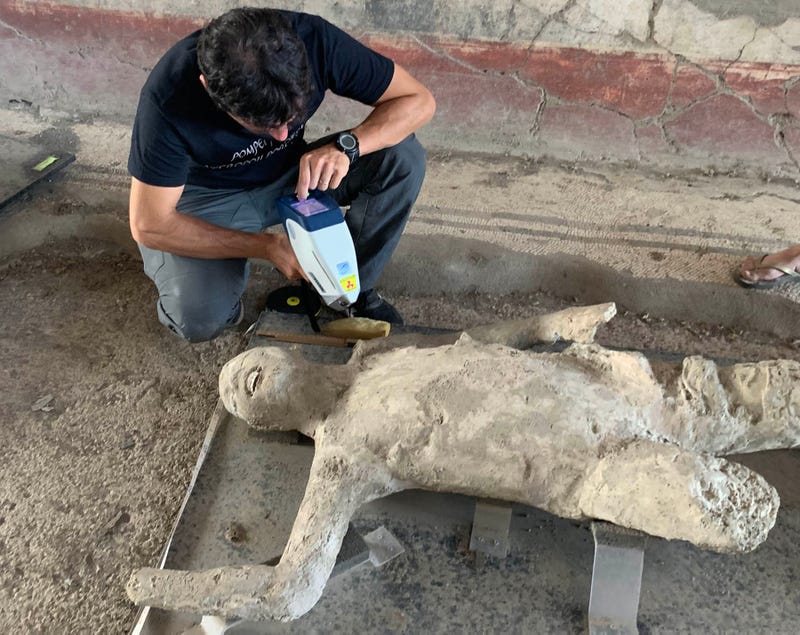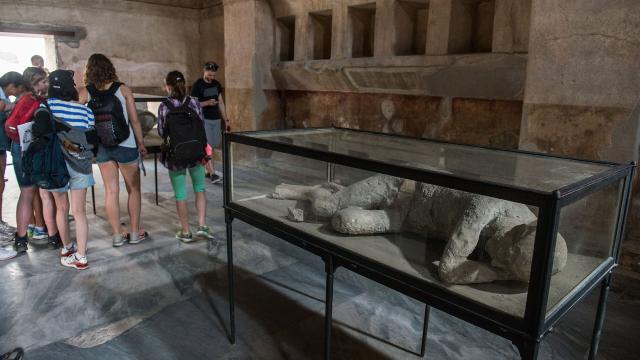Researchers studying the remains of six individuals from Pompeii concluded they asphyxiated during the volcanic eruption that doomed the town nearly 2,000 years ago.
The research team used portable X-ray fluorescence to determine the elemental composition of the Pompeii victims’ bones, as well as the plaster used to make casts of the victims’ death poses. Their research was published today in PLoS ONE.
“This [could] create a protocol to be carried out in more Pompeii casts that were found in different Pompeii areas, but as well should be done in remains around the Vesuvian area like in Herculano [Herculaneum,]” said Gianni Gallello, an archaeologist at the University of Valencia and co-author of the paper, in an email to Gizmodo.
When Vesuvius erupted, it produced pyroclastic flows—fast-moving accumulations of ash, gas, and lava—that buried the town below. Individuals that had been taking shelter from the volcano’s preliminary outburst, a “hellish rain” of pumice and ash, were buried under feet of ash carried by the superheated flows.
“When their bones suffered the effects of the high temperatures caused by the pyroclastic waves and magma currents, the victims had already died, probably from inhaling toxic gasses,” said Llorenç Alapont, an archaeologist at the University of Valencia and the study’s lead author, in a university release.
The ash then cooled and hardened, and the bodies buried beneath its layers decomposed, leaving only the victims’ bones. Flash forward to the late 19th century, when Italian archaeologist Giuseppe Fiorelli developed a technique to pour plaster into voids left in the hardened ash by the bodies’ final positions. The casts showcase details of the victims’ faces, teeth, and even preserved folds in their clothing.

There is some debate surrounding what killed the residents of Pompeii (as well as the neighbouring town of Herculaneum) when Vesuvius erupted. Was it the superhot pyroclastic flows? In 2020, researchers claimed they found brain tissue in one of the Herculaneum victims that had turned to glass, apparently due to the heat of the eruption. Perhaps the residents were killed by giant rocks that landed on peoples’ heads (It wasn’t that)?
The recent team says their findings bolster the idea that many residents died of asphyxia induced by the pyroclastic flows. The researchers analyzed six casts from Pompeii’s Porta Nola area and one cast from Terme Suburbane. The Porta Nola individuals were fleeing the city at the time, according to the team, and would have been navigating terrain covered with lapilli—basically, crumbly bits of volcanic ejecta. At least one of the individuals the team studied used a branch as a walking stick.
Elemental data from the individuals’ buried bones indicated that the plaster poured to make the casts affected the elemental profiles of some of the bones. And importantly, the casts studied by the team are not in the “pugilistic pose” many bodies take on when subjected to extreme heat. The pose—named for a boxer’s stance—is the result of the body dehydrating, and its muscles contracting after heat exposure.
According to the team, the gas-ash mixture was not extremely high in the area of these victims, but would not have been breathable for more than a few minutes. Regardless, the hot ash laid down by the pyroclastic flows would have had a “thermal impact” on the asphyxiated corpses as they were buried, the researchers wrote.
Down the line, it’s possible that portable X-ray fluorescence (pXRF) analysis could improve scientists’ non-invasive probing of the Roman remains. Despite the 1,944 years between us and them, new scientific approaches are allowing us to better understand the final moments in lives of Pompeii’s people.
